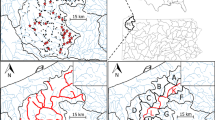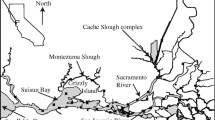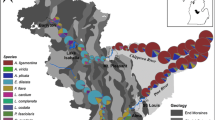Abstract
This study attempts to determine the scale-dependent hierarchical spatial variation and longitudinal distributions of Sicyopterus japonicus year round. The distribution of S. japonicus in the Datuan Stream in northern Taiwan was surveyed during the fall and winter 2007, as well as the spring and summer of 2008. The spatial structure of S. japonicus density was modeled using geostatistics. The longitudinal distributions of S. japonicus density were then estimated using kriging and hydrology distance with nested variogram models. Variography results indicate that nested variogram models could reflect the hierarchical structure in the spatial variation of seasonal S. japonicus density, with the small, median, and large ranges representing three nested scales. Models for the four seasons were consistent in that they shared the same shape of variogram models with various ranges and sill values. This model shape consistency implies stationary spatial correlations in the longitudinal fish distribution across the four seasons. The Kriging geostatistical method based on the multiple scales nested variogram models also provided robust estimates of S. japonicus densities at unsampled sections. We conclude that S. japonicus densities exhibit hierarchical patterns and variation in the four seasons along the study stream. Geostatistical methods with a nested variograms and hydrological distance are a highly effective means of delineating the hierarchical structure in longitudinal patterns of S. japonicus density in each season, providing estimates of the S. japonicus density for hierarchically structured spatial distributions and expanding knowledge of S. japonicus beyond the limits imposed by spatial and temporal scales.
Similar content being viewed by others
References
Abe, S., Iguchi, K., Ito, S., Uchida, Y., Ohnishi, H., & Ohmori, K. (2003). Habitat use of the grazing goby (Sicyopterus japonicus) in response to spatial heterogeneity in riparian shade. Journal of Freshwater Ecology, 18, 161–167.
Abe, S., Yodo, T., Matsubara, N., & Iguchi, K. (2007). Distribution of two sympatric amphidromous grazing fish Plecoglossus alivelis Temminck & Schlegel and Sicypoterus japonicus (Tanka) along the course of a temperate river. Hydrobiologia, 575, 415–422.
Allan, J. D., & Johnson, L. B. (1997). Catchment scale analysis of aquatic ecosystem. Freshwater Biology, 37, 107–111.
Angermeier, P. L., & Schlosser, I. J. (1989). Species-area relationships for stream fish. Ecology, 70, 1450–1462.
Aukema, J. E. (2004). Distribution and dispersal of desert mistletoe is scale-dependent, hierarchically nested. Ecography, 27, 137–144.
Barbour, M. T., Gerritsen, J., Snyder, B. D., & Stribling, J. B. (1999). Rapid bioassessment protocols for use in streams and wadeable rivers: Periphyton, benthic macroinvertebrates and fish (2nd ed.). Washington. DC: USEPA. EPA 841-B-99–002.
Bellehumeur, C., & Legendre, P. (1998). Multiscale sources of variation in ecological variables: Modeling spatial dispersion, elaborating sampling designs. Landscape Ecology, 13, 15–25.
Bellier, E., Monestiez, P., Durbec, J. P., & Candau, J. N. (2007). Identifying spatial relationships at multiple scales: Principal Coordinates of Neighbour Matrices (PCNM) and geostatistical approaches. Ecography, 30, 385–399.
Carroll, S. S., & Pearson, D. L. (2000). Detecting and modeling spatial and temporal dependence in conservation biology. Conservation Biology, 14, 1893–1897.
Chilès, J. P., & Delfiner, P. (1999). Geostatistics: Modeling spatial uncertainty. New York: Wiley.
Cressie, N. A. C. (1993). Statistics for spatial data, revised Edition edn. New York: Wiley.
Cressie, N., Frey, J., Harch, B., & Smith, M. (2006). Spatial prediction on a river network. Journal of Agricultural Biological and Environmental Statistics, 11, 127–150.
Dôtu, Y., & Mito, S. (1955). Life history of the gobioid fish, Sicydium japonicum Tanaka. Science Bulletin of the Faculty of Agriculture Kyushu university, 10, 120–126.
Durance, I., Celine, L., & Ormercod, S. J. (2006). Recognizing the importance of scale in the ecology and management of riverine fish. River Research and Applications, 22, 1143–1152.
Fausch, K. D., & Young, M. K. (1995). Evolutionarily significant units and movement of resident stream fishes: A cautionary tale. In J. L. Nielsen (Ed.), Evolution and the aquatic ecosystem: Defining unique units in population conservation (pp. 360–370). Monterey: American Fisheries Society Symposium.
Fausch, K. D., Torgersen, C. E., Baxter, C., & Hiram, W. L. (2002). Landscapes to riverscapes: Bridging the gap between research and conservation of stream fishes. BioScience, 52, 483–498.
Frissell, C. A., Liss, W. J., Warren, C. E., & Hurley, M. D. (1986). A hierarchical framework for stream habitat classification: Viewing streams in a watershed context. Environmental Management, 10, 199–214.
Ganio, L. M., Torgersen, C. E., & Gresswell, R. E. (2005). A geostatistical approach for describing spatial pattern in stream networks. Frontiers in Ecology and the Environment, 3, 138–144.
Gowan, C., & Fausch, K. D. (1996). Mobile brook trout in two high-elevation Colorado streams: Re-evaluating the concept of restricted movement. Canadian Journal of Fisheries and Aquatic Sciences, 53, 2626–2637.
Grenouillet, G., Pont, D., & Hérissé, C. (2004). Within-basin fish assemblage structure: The relative influence of habitat versus stream spatial position on local species richness. Canadian Journal of Fisheries and Aquatic Sciences, 61, 93–102.
Gresswell, R. E., Torgersen, C. E., Bateman, D. S., Guy, T. J., Hendricks, S. R., & Wofford, J. E. B. (2006). A spatially explicit approach for evaluating relationships among coastal cutthroat trout, habitat, and disturbance in small Oregon streams. American Fisheries Society, 48, 457–471.
Hobert, J. P., Altman, N. S., & Schofield, C. L. (1997). Analysis of fish species richness with spatial covariate. Journal of the American Statistical Association, 92, 846–854.
Imhoff, J. G., Fitzgibbon, J., & Annable, W. K. (1996). A hierarchical evaluation system for characterizing catchment ecosystems for fish habitat. Canadian Journal of Fisheries and Aquatic Sciences, 53, 312–326.
Inoue, M., & Miyayoshi, M. (2006). Fish foraging effects on benthic assemblages along a warm-temperate stream: differences among drift feeders, benthic predators and grazers. Oikos, 114, 95–107.
Labbe, T. R., & Fausch, K. D. (2000). Dynamics of intermittent stream habitat regulate persistence of a threatened fish at multiple scale. Ecological Applications, 10, 1774–1791.
Li, J., Herlihy, A., Gerth, W., Kaufmann, P., Gregory, S., Urquhart, S., et al. (2001). Variability in stream macroinvertebrate at multiple spatial scale. Freshwater Biology, 46, 87–97.
Liang, S. H. (2005). Developing models for freshwater bio-monitoring. Taipei: National Park Workshop.
Liebhold, A. M., & Gurevitch, J. (2002). Integrating the statistical analysis of spatial data in ecology. Ecography, 25, 533–557.
Lin, Y. P., Yeh, M. S., Deng, D. P., & Wong, Y. C. (2008). Geostatistical approaches and optimal additional sampling schemes for spatial patterns and future sampling of bird diversity. Global Ecology and Biogeography, 17, 175–188.
Lloyd, N. J., Mac, N. R., & Lake, P. S. (2006). Spatial scale of autocorrelation of assemblages of benthic invertebrates in two upland rivers in south-eastern Australia and its implications for biomonitoring and impact assessment in streams. Environmental Monitoring and Assessment, 115, 69–85.
Maddock, I. (1999). Importance of physical habitat assessment for evaluating river health. Freshwater Biology, 41, 373–391.
Magalhães, M. F., Batalha, D. C., & Collares-Pereira, M. J. (2002). Gradients in stream assemblages across a Mediterranean landscape: Contributions of environmental factors and spatial structure. Freshwater Biology, 47, 1015–1031.
Menge, B. A., & Olson, A. M. (1990). Role of scale and environmental factors in regulation of community structure. Trends in Ecology & Evolution, 5, 52–57.
Nash, J. E., & Sutcliffe, J. V. (1970). River flow forecasting through conceptual models, Part I - A discussion of principles. Journal of Hydrology, 10, 282–290.
Peterson, E. E., et al. (2006). Patterns spatial autocorrelation in stream water chemistry. Environmental Monitoring and Assessment, 121, 571–596.
Peterson, E. E., Theobald, D. M., & Hoef, J. M. V. (2007). Geostatistical modeling on stream networks: Developing valid covariance matrices based on hydrological distance and stream flow. Freshwater Biology, 52, 267–279.
Rivoirard, J., Simmonds, J., Foote, K., Fernandes, P., & Bez, N. (2000). Geostatistics for estimating fish abundance. Boston: Blackwell.
Schlosser, I. J. (1991). Stream fish ecology: A landscape perspective. Bioscience, 41, 704–712.
Schlosser, I. J. (1995). Critical landscape attributes that influence fish population dynamics in headwater streams. Hydrobiologia, 303, 71–81.
Shen, K. N., & Tzeng, W. N. (2002). Formation of a metamorphosis check in otoliths of the amphidromous goby Sicyopterus japonicus. Marine Ecology-Progress Series, 228, 205–211.
Shen, K. N., Lee, Y. C., & Tzeng, W. N. (1998). Use of otolith microchemistry to investigate the life history pattern of gobies in a Taiwanese stream. Zoological Studies, 37, 322–329.
Thompson, A. R., Petty, J. T., & Grossman, G. D. (2001). Multiscale effects of resource patchiness on foraging behaviour and habitat use by longnose dace, Rhinichthys cataractae. Freshwater Biology, 46, 145–160.
Torgersen, C. E., & Close, D. A. (2004). Influence of habitat heterogeneity on the distribution of larval Pacific lamprey (Lampetra tridentata) at two spatial scales. Freshwater Biology, 49, 614–630.
Torgersen, C. E., Gresswell, R. E., & Bateman, D. S. (2004). Pattern detection in stream networks: Quantifying spatial variability in fish distribution. In T. Nishida, P. J. Kailola & C. E. Hollingworth (Eds.), Proceedings of the second annual international symposium on GIS/Spatial analyses in fishery and aquatic sciences (pp. 405–420). Saitama: Fishery GIS Research Group.
Torgersen, C. E., Li, H. W., McIntosh, B. A., & Price, D. M. (1999). Multiscale thermal refugia and stream habitat associations of chinook salmon in northeastern Oregon. Ecological Applications, 9, 301–319.
Ver Hoef, J. M., Peterson, E., & Theobald, D. (2006). Spatial statistical models that use flow and stream. Environmental and Ecological Statistics, 13, 449–464.
Vilizzi, L., Copp, G. H., & Roussel, J. M. (2005). Assessing temporal variation and autocorrelation in fish habitat use. Folia Zoologica, 54, 432–442.
Wackernagel, H. (2003). Multivariate geostatistics: An introduction with applications. New York: Springer.
Webster, R., & Oliver, M. A. (2001). Geostatistics for environmental scientists. Chichester: Wiley.
Wilkinson, C. D., & Edds, D. R. (2001). Spatial pattern and environmental correlates of a midstream stream fish community: Including spatial autocorrelation as a factor in community analyses. American Midland Naturalist, 146, 271–289.
Author information
Authors and Affiliations
Corresponding author
Rights and permissions
About this article
Cite this article
Lin, YP., Wang, CL., Chang, CR. et al. Estimation of nested spatial patterns and seasonal variation in the longitudinal distribution of Sicyopterus japonicus in the Datuan Stream, Taiwan by using geostatistical methods. Environ Monit Assess 178, 1–18 (2011). https://doi.org/10.1007/s10661-010-1666-2
Received:
Accepted:
Published:
Issue Date:
DOI: https://doi.org/10.1007/s10661-010-1666-2




